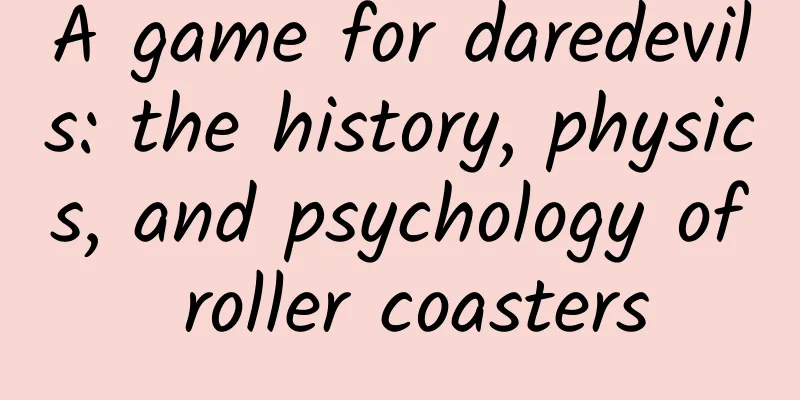A game for daredevils: the history, physics, and psychology of roller coasters

|
The pursuit of excitement is human instinct. Written by Qu Lijian History of Roller Coasters Russian ice slide, the predecessor of the roller coaster The predecessor of the roller coaster was the ice slide, which was an exciting activity created by Russians as early as the 15th century. The ice slide was built with wood, and the wooden ramp was covered with ice and snow. People climbed up the wooden steps, which was equivalent to the height of seven or eight floors today, to the top of the slide, and then sat on the sled and slid down the slope of about 50 degrees. It’s icy and exciting, and feels like flying. In the 18th century, Russia made the ice slide more exciting. The slide was no longer just one slide, but a combination of multiple slides. Along the mountain and across the river, you can slide down one slide and then down the next slide in the magnificent scenery. The ice slides are decorated with colorful flags during the day and lit with torches at night. If you can't slide enough during the day, you can slide at night. Ice slides even entered the Tsar’s palace, and princes, nobles, and dignitaries spared no expense to take risks for the thrill. Russian ice slides gradually spread to Western Europe, and their designs also improved. "Russian Hill", the originator of roller coasters. In 1804, a slide was built in Paris, France, adding wheels to the sled and named "Russian Mountain" (French name "Les Montagnes Russes"). This slide is regarded as the ancestor of the modern roller coaster. The car slide is free from the constraints of nature and can be played even in non-winter seasons. Russian Mountain is not only exciting, but also dangerous, with numerous injuries. Ironically, it was more attractive to people at the time. In 1817, the French made further improvements, with stronger wheels and tracks installed on the slope. The slide in Paris, called "The Promenades-Aériennes" (French name "The Promenades-Aériennes"), is considered the first modern roller coaster in history. The Promenades-Aériennes (French name), the first modern roller coaster. In 1846, Paris made further changes to the ramp, adding a circular track with a diameter of 4 meters. In 1887, a large slide was built in the Belleville area of Paris. It consisted of four sections of figure-8 tracks and was 200 meters long. It was called "Belleville Russian Mountain" (French name: Montagnes Russes de Belleville). The period from the end of the 19th century to World War I was known as the "Belle Époque" in Europe, with technological progress, economic boom, and no large-scale wars. Car slides became increasingly popular. "Belleville Russian Hill" In French and Spanish, roller coasters are called "Russian mountains". In Russia, roller coasters are called "American mountains". This is because Americans developed roller coasters and brought them back to Russia. In the 1850s, a section of abandoned mountain railroad in Pennsylvania, USA, was used by people to seek excitement. People sat on the car and went down the track. This kind of entertainment was called "Gravity Railroad". Gravity Railway Gravity railroads inspired businessman and inventor LaMarcus Adna Thompson, who designed the Zigzag Railway, which opened in 1884 at Coney Island, New York. The real roller coaster is finally here. Thompson's business was very successful and he recovered all his costs within a week of opening. LaMarcus Adna Thompson (March 8, 1848 - May 8, 1919) was an American entrepreneur and inventor, the father of the modern roller coaster. Schematic diagram of the zigzag railway invented by Thompson The Zigzag Railway amusement ride at Coney Island, New York, 1884. Thompson's success attracted many imitators. Coney Island became a testing ground for roller coasters, with all kinds of innovative, bizarre, dangerous and suicidal rides. Someone even designed a cannon roller coaster, where the body of the car is shot out of a cannon, flies a certain distance, and lands on another track. But this roller coaster ultimately failed to be successfully tested. The circular roller coaster experiment was successful, but the safety and experience were relatively poor, and it was not commercially successful, with too few passengers and insufficient revenue to cover expenses. The circular track didn't make money back then The person who made substantial improvements to roller coasters was John Miller of Thompson Company. He had more than 100 patents for roller coasters in his lifetime and designed and participated in the design of more than 150 roller coasters. Miller first greatly improved the safety of roller coasters and redesigned various tracks to make roller coasters run faster and more exciting. Miller is known as the "father of modern high-speed roller coasters." John Mueller (1872 – June 24, 1941) was an American roller coaster designer, inventor, and entrepreneur. The roller coaster industry flourished until the Great Depression of 1929. This was the golden age of roller coasters, with more than 1,500 roller coasters built around the world. Many roller coaster designers made fortunes and left their creativity behind. Designer Harry Traver began to consider abandoning wooden tracks and using steel tracks, but before his idea could be implemented on a large scale, the Great Depression hit. After the outbreak of World War II, the roller coaster lost its tourists and had to stop operating or even be demolished. After World War II, the United States was thriving, and ordinary families had money and leisure. Disney saw the needs of people and built Disneyland, and built a new roller coaster in it. The Matterhorn Roller Coaster at Disneyland ushered in the era of steel track roller coasters. In 1959, the roller coaster at Disneyland in California was built, and its entire form imitated the Matterhorn in the Swiss Alps. Its biggest innovation was that it abandoned the wooden track and adopted the steel track. Steel tracks made it easier to design more challenging tracks. Since then, various creative tracks have continued to appear, and roller coasters have become faster, higher, and longer, constantly surpassing themselves and ushering in their heyday. The Decepticon roller coaster at Beijing Universal Studios will start operating in 2021 Enjoy the acceleration Roller coasters bring enjoyment to people. The first principle is that the human body responds to changing forces, stimulating the body to secrete neurochemicals such as adrenaline and dopamine. The force per unit mass of a person on a roller coaster is the force of the roller coaster. According to Newton's second law, it is the total acceleration minus the acceleration due to gravity, divided by the magnitude of the acceleration due to gravity, which is called G force. . For the safety of tourists, roller coaster standards have regulations on the magnitude of G-force. G force is a vector, and is generally decomposed in the biomechanical coordinate system. The definition of the biomechanical coordinate system is shown in Figure 1: Figure 1 Biomechanical coordinate system Figure 2 The oval graph shows the maximum values of the G-force components of a roller coaster. The actual values of a roller coaster are drawn inside the oval graph. The International Organization for Standardization (ISO) defines the safe range of G-force for roller coasters as an oval diagram, as shown in Figure 2. There are also limits on the time that tourists can withstand G-forces. For G=6, the duration must not exceed 1 second; for G=5, the duration must not exceed 2 seconds. The smaller the G, the longer the duration is allowed. Figure 3 shows the G-force record of a roller coaster. The maximum G-force is 4, and the duration is less than the 6 seconds specified by the standard. Figure 3. G-force variation over time during the descent of a roller coaster. The relevant standards also have restrictions on the rate of change of G force over time (i.e. the derivative of acceleration with respect to time, called jerk). According to the ISO standard, the maximum jerk in the acceleration phase is 15g/s, and the maximum jerk in the deceleration phase is 0.8g/s. It can be seen that the roller coaster in Figure 3 meets this requirement. When you ride a roller coaster, you don't have to bother measuring acceleration to see if the roller coaster meets the standards. Roller coasters are special equipment and are strictly regulated by the state. It is believed that catastrophic accidents are unlikely to occur on operating roller coasters. All you have to do is feel the pleasure, scream and enjoy the acceleration. As the roller coaster swoops down, you can feel your internal organs moving. Your body is not a monolithic entity. When you accelerate, each part of your body accelerates separately. The seat pushes on your back, the muscles in your back push on your organs, and those organs push on the organs in front of them. If you are in free fall (the time period in Figure 3 when the G force is close to 0 or -1), the parts of your body are no longer pushing against each other, but falling independently. You will feel like you are floating inside your body. You can also get a more intuitive sense of the equivalence of gravity and inertial mass. It was after Einstein figured this out that he quickly completed his theory of general relativity. If the force changes, it will feel more exciting. Please be mentally prepared and get on the circular track. In the early 20th century, circular tracks were circular. At the bottom of the track, the acceleration was too high, which made people uncomfortable. The acceleration changed too much during the whole process, which could easily sprain tourists. Nowadays, circular tracks are generally no longer perfect circles, but teardrop-shaped, with a larger curvature at the bottom and smaller at the top, which reduces the rate of change of acceleration. What’s even more exciting is that the roller coaster can roll along the track, sometimes above the track and sometimes below the track. Guangzhou Chimelong Roller Coaster Roller Coaster Psychology Roller coasters are popular all over the world. Many amusement parks often have a "two-hour queue and two-minute ride" scene. Why do we humans like to ride roller coasters? An obvious answer is the pursuit of excitement. In psychological terms, it is for sensation seeking. Sensation seeking refers to the personality trait of individuals seeking varied, novel, complex, and intense sensations and experiences, and taking risks in terms of physiology, society, law, and economy to obtain the above experiences. Sensation seeking includes four parts, namely, stimulation and risk seeking, experience seeking, disinhibition, and desensitization. To put it bluntly, it's just courting death. Riding a roller coaster obviously falls into the category of thrill and adventure seeking, and is lumped into the same category as rock climbing, scuba diving, skydiving, death selfies, etc. What makes roller coasters thrilling? The intuitive answer is speed, but psychologists have found that there is insufficient evidence to support a direct correlation between speed and sensation seeking. For example, many speed racers are not sensation seeking; some engage in risk-taking behavior in specific situations. Psychologists believe that roller coasters provide excitement through fear, just like watching a horror movie. Fear increases the glucose level in the body, causing physiological conditions such as a pounding heart, panting, and full of energy, which is called the "fight or flight response" in psychology. Studies have confirmed that riding a roller coaster can produce this response. Can the fight-or-flight response and sensory stimulation coexist in a safe environment? Research on bungee jumping has found that the two can coexist. After a bungee jump, newcomers not only feel refreshed and extremely excited, but also have increased levels of endorphins in their blood, a well-known happy substance secreted by the brain. Bungee jumpers also had elevated levels of cortisol in their blood, and people secrete more cortisol when they are stressed. Can a person feel anxious and happy at the same time? The answer is that not all human stress is bad. Good stress is called positive stress (Eustress, also called benign stress). Roller coaster passengers can also experience positive stress. When Dutch scientists studied the relationship between asthma and stress, they found that volunteers with asthma experienced reduced asthma symptoms after riding a roller coaster. The researchers believe that the reason is that they experienced positive stress. I wonder if riding a roller coaster could be a treatment for asthma, two laps for one course? Not everyone likes to ride a roller coaster, and individual differences may be explained by brain chemistry. In addition to endorphins, the brain also secretes another happy substance - dopamine. High endorphin levels are more likely to be the body's natural reaction to experiencing "dangerous situations", while people with high dopamine levels are more likely to seek excitement, such as riding roller coasters, taking drugs, stealing, etc. Psychology currently cannot answer the real psychological reason why people enjoy roller coasters. Perhaps there is no single reason, but a combination of factors such as high-speed passion, overcoming fear, and physiological stimulation. The current era is mild, safe, and even boring, which is actually a blessing for humans. Even more fortunately, we can spend a little money to secrete adrenaline, endorphins, and dopamine in a very safe environment, and experience excitement, happiness, and pleasure. Our ancestors could only experience the experience brought by these hormones when they were alert or dealing with danger. References https://en.wikipedia.org/wiki/Roller_coaster https://www.britannica.com/topic/roller-coaster#ref910739 https://physicsworld.com/a/twists-turns-thrills-and-spills-the-physics-of-rollercoasters/ Phys. Educ. 2020, 55, 065012 https://theconversation.com/the-psychology-of-roller-coasters-99166 |
<<: If you want to learn how to cook at home, please learn how to read recipes first!
Recommend
App promotion and operation example: 5,000 paying users before the product is launched, generating 2 million in turnover
Hello everyone, I am Xiaoxiao who is challenging ...
The world's largest! The glass ball in the Greater Bay Area that explores the beginning of the universe is fully built!
Author: Li Chuanfu Shi Xiangqi On October 11, 202...
Three basic operating modes for members!
In the current Internet environment, user operati...
New smart home experience: Touch your iPhone to turn on the lights
Beijing time, November 4th morning news, Broadcom...
From Roewe RX5 to MG ZS, why are Alibaba's Internet cars more reliable than Tesla?
Alibaba, which recently teamed up with Roewe to l...
Wang Hao's new posture correction-posture assessment and rehabilitation
Wang Hao's new body correction - body assessm...
How much does a WeChat mini program cost? How much does it cost to make a WeChat mini program?
As an application based on the WeChat ecological ...
Don’t get lost when seeing a doctor | What the hell, how to see a doctor for respiratory diseases
...
Coke addicts: Dopamine makes you addicted, sugar makes you old
Fried chicken and cola, the more you eat, the hap...
Sky-high prices for sports event copyrights: Is the pay-per-view model the ultimate weapon?
Tencent paid 500 million US dollars for the exclu...
Are the "gerbils" that drink water with their ears in "Dune 2" real?
The cute "Jerboa" that appeared in the ...
Good news for diabetics! Can this cow produce milk containing human insulin? This cow is really amazing →
Compiled by: Gong Zixin Diabetes mellitus, caused...
How does Taobao Affiliate make money through promotion? How does Alimama Taobao Affiliate Promotion make money?
How does Taobao Alliance make money? Regarding th...
Get a full refund from VATTI World Cup, and talk about the 5 correct approaches to new media marketing
The World Cup is over, France won the championshi...
Definition, advantages and disadvantages of CPA advertising
Definition of CPA Advertising The CPA (Cost Per A...









